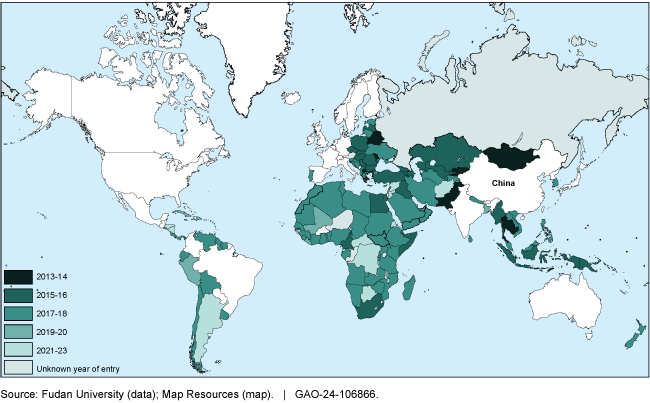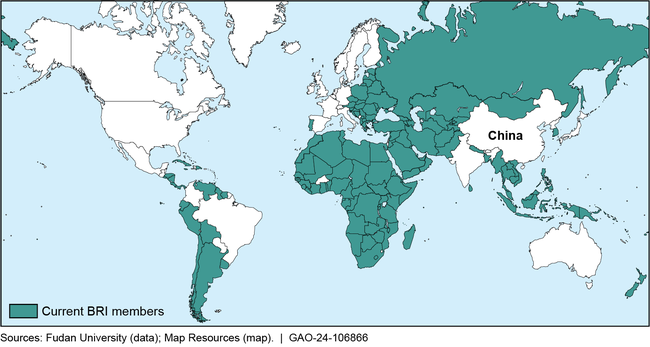International Infrastructure Projects: China's Investments Significantly Outpace the U.S., and Experts Suggest Potential Improvements to the U.S. Approach
Fast Facts
China's Belt and Road Initiative is the world's largest infrastructure finance program. It has funded roads, ports, and other projects around the world, and has expanded China's influence.
We found:
From 2013-2021, China provided $679 billion for infrastructure projects in transportation, energy, and three other sectors, while the U.S. provided $76 billion in the same sectors
China's infrastructure projects had some benefits for host countries but contributed to unsustainable debt and other issues
Experts proposed options to address challenges to U.S. international infrastructure efforts, such as improving strategic coordination.
Countries that signed agreements with China to join its Belt and Road Initiative, by year of entry

Highlights
What GAO Found
From 2013 to 2021, the People's Republic of China (PRC) provided $679 billion for infrastructure projects through the Belt and Road Initiative (BRI) in five key infrastructure sectors, while the U.S. provided $76 billion in the same sectors. Projects financed through the BRI include power plants, railways, highways, ports, and telecommunications infrastructure. Russia was the largest recipient of BRI assistance from 2013 to 2021. The PRC has provided BRI financing through government-to-government loans. U.S. assistance has included a mix of loans, insurance, grants, and loan guarantees, generally for private entities. Mozambique was the largest recipient of U.S. assistance.
Countries That Have Signed BRI Agreements with China

According to various reports, many BRI projects have been associated with some economic benefits for host countries but have frequently contributed to unsustainable debt and other issues. BRI host countries have seen benefits such as economic development from expanded infrastructure and energy generation. However, according to reports, some PRC-financed projects were considered unsustainable, and some had weak environmental, social, or governance standards.
Experts who participated in a GAO-organized workshop identified various policy options to help the U.S. address challenges that hinder U.S. foreign assistance for international infrastructure projects. For example, they identified challenges such as the lack of a public national strategy to guide and prioritize U.S. efforts and the fragmentation of foreign assistance efforts across several federal agencies. Policy options to potentially improve U.S. assistance for international infrastructure projects include increased risk tolerance to attract private sector investment and enhanced capacity building in host countries. Experts also proposed specific modifications to implement these options, including modifications to streamline agency processes that affect timeliness and coordination.
Why GAO Did This Study
The BRI is the PRC's signature foreign policy initiative that aims to strengthen the PRC's global standing and influence. This initiative seeks to expand the foreign presence of Chinese state firms, create new markets for PRC goods, and secure access to strategic commodities for the PRC's' economic development. The BRI is considered by some observers to pose a significant challenge to U.S. economic, political, and security interests around the world.
The James M. Inhofe National Defense Authorization Act for Fiscal Year 2023 includes a provision for GAO to assess the effects of BRI projects on host countries and U.S. interests. This report examines, among other objectives, the nature and scope of the BRI and of U.S. foreign assistance for international infrastructure projects, and the reported effects of BRI investments on host countries. This report also discusses policy options that were identified by experts as having the potential to improve U.S. assistance for international infrastructure projects.
To address these objectives, GAO:
- conducted a literature review;
- analyzed data;
- conducted site visits to and spoke with officials in Angola, Indonesia, and Kenya—all major BRI recipients and selected because of the range of PRC loans received and level of U.S. investment;
- interviewed U.S. government officials; and
- organized an expert workshop with 28 experts from academia, think tanks, and U.S. government agencies.
For more information, contact Nagla’a El-Hodiri at (202) 512-7279 or ElHodiriN@gao.gov.
